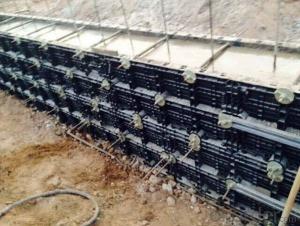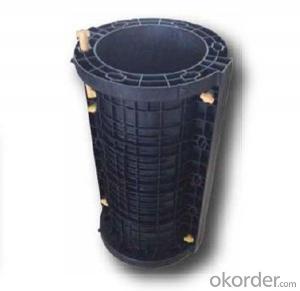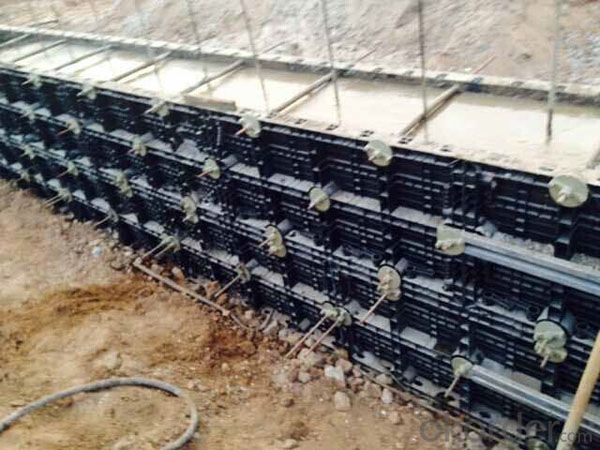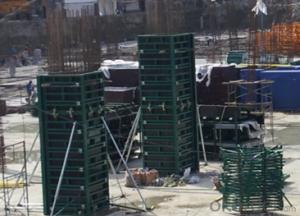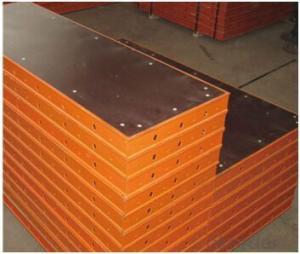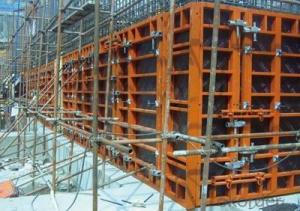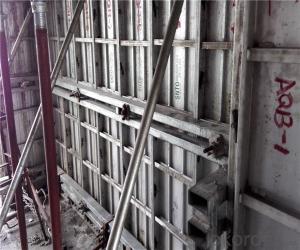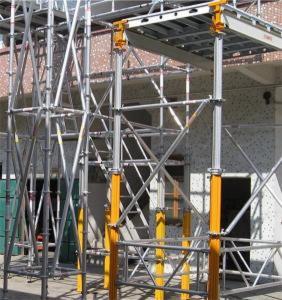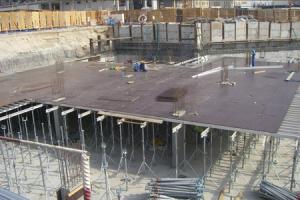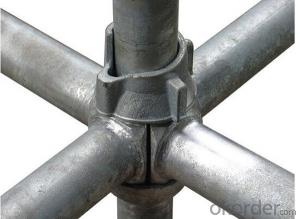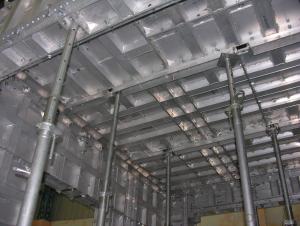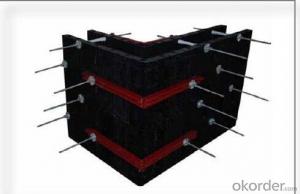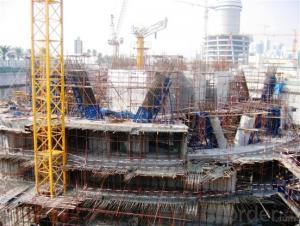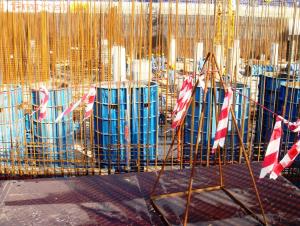Aluminum Scaffolding Beam Formwork Scaffolding Base Plate New Design
- Loading Port:
- Tianjin
- Payment Terms:
- TT OR LC
- Min Order Qty:
- 10000 set
- Supply Capability:
- 50000 set/month
OKorder Service Pledge
OKorder Financial Service
You Might Also Like
Aluminum Scaffolding Beam Formwork Scaffolding Base Plate New Design
Plastic Formwork Concrete Formwork Fiberglass Scaffolding Japan Standard Scaffolding Made in China
Developing with new technology materials, steel formworks is no longer a must in construction concrete process. More and more buildings are established with plastic formworks. And workers love this new formworks much more.
The advantages of plastic formworks:
Aluminum Scaffolding Beam Formwork Scaffolding Base Plate New Design
1.First of all--light
Yes it is the first advantage of plastic formwork. It wins the great praise of both contractors and workers.
The biggest panel is 120×1500px,weights 10.5kg only. It can be lift and set up by one person easily, which means there is no need for cranes on site.Saves a lot of cost and time.
2.Easy set up
Different size of panels can firmly locked by simply turn the special handles to 90 degree. The Panels has rib on the back, which makes the system need not traditional wood blocks and nails. The panels have holes to fit tie rod, guarantee the strength of the whole system.
3.Modularity
Modular formworks composed by different size of panels,the main item is 120×1500px panel,which is used for the large area of walls and slabs. There are also small size of panels like 10×1500px,20×1500pxcm,25×1500px,inner corner 20×20×1500px and outer corner 10×5×1500px.Due to the variety of panel size, the system can form almost all size walls 120×1500px panel of multiply by 125px. The material of modular formwork is PC-ABS mixed with special glass fibers which enable panels to hold high pressures.
4.Strength
The handles are made by high strength Nilon, each panel locked by at least 4 handles, which makes the whole system strong enough to pour 1000px walls. Aluminum Scaffolding Beam Formwork Scaffolding Base Plate New Design
* Good loading capacity
* Easy to assemble and dismantle
* Stable and durable thanks to its structual design & automatic welding quality
Aluminum Scaffolding Beam Formwork Scaffolding Base Plate New Design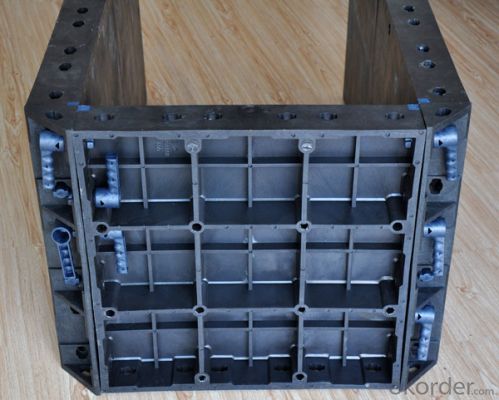
Aluminum Scaffolding Beam Formwork Scaffolding Base Plate New Design
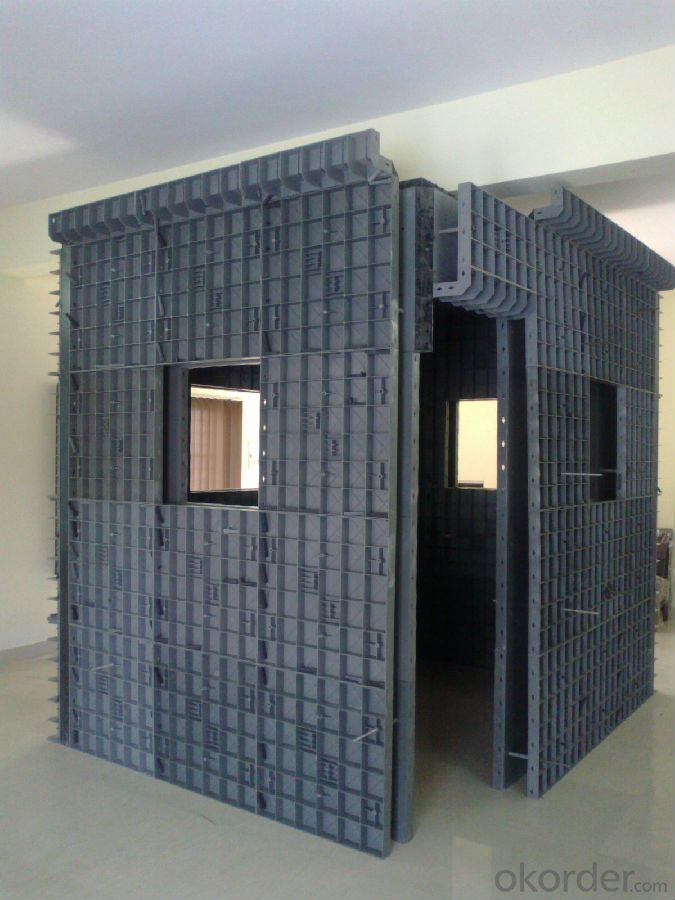
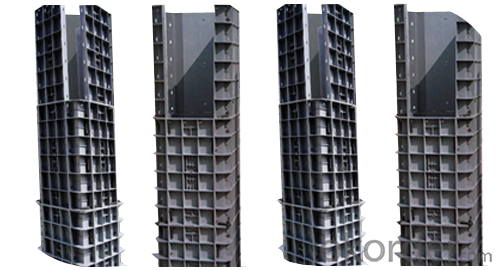
FAQ
We have organized several common questions for our clients,may help you sincerely:
Why Us?
We are one of the Top 500 in the world, largest construction materials supplier in China. Also we are a state-owned company and respond to every customer with large and also small orders.
We own professional manufacturers with powerful producing capacity.
Extensive and comprehensive quality control system
- Q: Are there any specific code or regulatory requirements for using steel frame formwork?
- Yes, there are specific code and regulatory requirements for using steel frame formwork in construction projects. These requirements may vary depending on the country and region, as different jurisdictions have their own building codes and regulations. In general, steel frame formwork systems must comply with structural design standards and codes that ensure the safety and integrity of the structures being built. These codes typically cover aspects such as load-bearing capacities, stability, and durability of the formwork system. For instance, in the United States, the American Concrete Institute (ACI) provides guidelines and standards for formwork design and construction. ACI 347R-14, "Guide to Formwork for Concrete," offers recommendations for steel formwork systems, including criteria for strength, stability, and dimensional tolerances. Similarly, the European Union has its own set of regulations and standards for formwork systems. The European Standard EN 12812:2008, "Falsework - Performance requirements and general design," specifies the requirements for steel formwork, including aspects such as load-bearing capacity, safety factors, and material properties. It is essential for contractors and designers to comply with these code and regulatory requirements when using steel frame formwork in construction projects to ensure the safety of workers and the structural integrity of the final building. Failure to adhere to these requirements may lead to accidents, structural failures, or non-compliance with building regulations, resulting in legal consequences and potential liability. Therefore, it is crucial to consult the relevant building codes and regulations in the specific jurisdiction where the construction is taking place to ensure compliance with the specific requirements for steel frame formwork.
- Q: Can steel frame formwork be used for commercial buildings?
- Yes, steel frame formwork can be used for commercial buildings. Steel frame formwork is a versatile and durable solution that is commonly used in the construction industry for various types of buildings, including commercial structures. It provides excellent strength and stability, allowing for the construction of high-rise buildings and large-scale commercial projects. Steel frame formwork is highly adaptable and can be easily customized to meet the specific requirements of different commercial building designs. Additionally, it offers a high-quality finish and can be reused multiple times, making it a cost-effective choice for commercial construction projects.
- Q: What are the different finishes available for steel frame formwork panels?
- Some of the different finishes available for steel frame formwork panels include galvanized, painted, and powder coated finishes.
- Q: What are the different types of release agents that can be used with steel frame formwork?
- Steel frame formwork can be used with various types of release agents. Some commonly used options include oil-based, water-based, wax-based, silicone-based, and barrier release agents. Oil-based release agents are the most frequently utilized for steel frame formwork. They consist of mineral oil and additives, providing a good release effect and easy application. These agents form a thin film on the formwork surface, preventing concrete from sticking. Water-based release agents are environmentally friendly and composed of water, surfactants, and additives. They are non-toxic and leave no residue on the formwork. These agents are ideal when oil-based options are not allowed or desired. Wax-based release agents, made from natural or synthetic waxes, are another choice. They offer excellent release properties and can be used in high-temperature scenarios. Wax-based agents result in a smooth and glossy finish on the formwork surface. Silicone-based release agents are renowned for their exceptional release properties. They are made from silicone oil and solvents, forming a durable film on the formwork surface. This film acts as an effective barrier between the concrete and formwork, providing long-lasting protection. Barrier release agents create a physical barrier between the formwork and concrete. They are made from polymers and solvents, forming an impermeable film on the formwork surface. This film prevents concrete from adhering. When selecting a release agent, it is crucial to consider the specific project requirements and the type of steel frame formwork being used. Factors such as temperature, curing time, and desired finish should be taken into account to choose the appropriate agent.
- Q: Can steel frame formwork be used in extreme weather conditions?
- Yes, steel frame formwork can be used in extreme weather conditions. Steel is known for its durability and strength, which makes it suitable for withstanding harsh weather conditions such as extreme temperatures, heavy rainfall, strong winds, and even snow. Unlike other materials, steel frame formwork is less likely to warp, crack, or degrade when exposed to extreme weather conditions. Additionally, steel formwork systems are designed to be easily assembled and disassembled, allowing for quick and efficient construction projects even in challenging weather conditions. However, it is important to ensure that the steel frame formwork is properly coated and protected against corrosion to maintain its longevity and performance in extreme weather conditions.
- Q: How does steel frame formwork handle different types of formwork edge protection?
- Steel frame formwork is a versatile and durable solution for construction projects, including formwork edge protection. It provides a strong and sturdy framework that allows for various types of formwork edge protection systems to be easily integrated. One common type of formwork edge protection used with steel frame formwork is the use of timber or plywood boards. These boards are fixed to the steel frame using screws or nails, creating a solid barrier along the edges of the formwork. This method provides a cost-effective and straightforward solution, as timber or plywood boards are readily available and can be easily cut to the required lengths. Another formwork edge protection system that can be used with steel frame formwork is the installation of steel or aluminum guardrails. These guardrails are designed specifically for edge protection and are securely attached to the steel frame using clamps or brackets. Steel or aluminum guardrails offer a higher level of safety and durability compared to timber or plywood boards, making them suitable for projects that require increased protection. In addition to timber boards and guardrails, steel frame formwork can also accommodate other types of edge protection systems such as plastic or rubber safety barriers. These barriers are lightweight, easy to install, and provide a flexible solution for formwork edge protection. They can be attached to the steel frame using a variety of methods, including clamps, brackets, or adhesive, depending on the specific requirements of the project. Overall, steel frame formwork is designed to handle different types of formwork edge protection systems effectively. Whether it is timber boards, steel or aluminum guardrails, or plastic safety barriers, the sturdy construction of the steel frame ensures that the formwork edge protection is securely in place, providing a safe working environment for construction workers.
- Q: How does steel frame formwork affect the overall waterproofing of a structure?
- Steel frame formwork can have a significant impact on the overall waterproofing of a structure. One of the main advantages of using steel frame formwork is its ability to provide a tight and secure enclosure for concrete pouring. This ensures that the concrete is properly contained and does not leak or seep out during the curing process. Furthermore, steel frame formwork is typically designed to be reusable, which means it can be used multiple times for different projects. This reusability factor helps in maintaining the integrity of the formwork system and prevents any potential leakage or seepage issues. It also allows for a more precise and accurate construction process, reducing the chances of gaps or voids that could lead to water penetration. In addition, steel frame formwork is known for its strength and durability. This strength translates into a robust and stable structure, which can better withstand external forces and environmental conditions that may compromise the waterproofing system. By providing a solid foundation and support for the concrete, steel frame formwork helps to ensure that the structure remains watertight and resistant to water damage. However, it is important to note that while steel frame formwork can greatly contribute to the overall waterproofing of a structure, it is not the sole factor responsible for it. Other elements, such as proper design, installation, and the use of appropriate waterproofing materials, are also crucial in achieving a watertight structure. In conclusion, steel frame formwork plays a vital role in the overall waterproofing of a structure. Its ability to provide a secure enclosure for concrete pouring, reusability, strength, and durability all contribute to creating a watertight and resilient structure. However, it should be used in conjunction with other waterproofing measures to ensure the best possible outcome.
- Q: What are the different types of concrete finishes that can be achieved with steel frame formwork?
- There are several different types of concrete finishes that can be achieved with steel frame formwork. 1. Smooth Finish: This is the most common type of finish achieved with steel frame formwork. It creates a smooth and even surface that is suitable for most applications. This finish is achieved by properly preparing the formwork and ensuring that it is level and free of any debris or imperfections. 2. Exposed Aggregate Finish: This type of finish is achieved by removing the top layer of concrete to expose the aggregate (such as stones or pebbles) beneath. The steel frame formwork can be designed to accommodate this finish by incorporating removable top panels or by using a specialized formwork system that allows for easy removal of the top layer of concrete. 3. Stamped Finish: This type of finish is achieved by using steel frame formwork that has a pattern or texture on its surface. The formwork is pressed into the fresh concrete, creating a pattern or texture that resembles stone, brick, or other materials. This finish is commonly used to enhance the aesthetic appeal of concrete surfaces, such as driveways, walkways, and patios. 4. Polished Finish: This type of finish is achieved by using steel frame formwork that has a smooth and non-porous surface. Once the concrete has cured, it is polished using specialized equipment and diamond abrasive pads. This process creates a highly reflective and smooth surface that is often used in high-end residential and commercial applications. 5. Stained Finish: This type of finish is achieved by applying a chemical stain or dye to the surface of the concrete. The steel frame formwork can be designed to accommodate this finish by incorporating a release agent or by using a specialized formwork system that allows for easy application of the stain or dye. This finish is commonly used to add color and visual interest to concrete surfaces, such as floors, countertops, and walls. Overall, steel frame formwork provides versatility and flexibility in achieving different types of concrete finishes. With proper planning, preparation, and execution, these finishes can enhance the visual appeal and functionality of concrete structures.
- Q: How does steel frame formwork handle different types of structural loads?
- Efficient and effective, steel frame formwork is designed to handle a wide range of structural loads. Its strength and rigidity make it an ideal material for effectively withstanding different types of loads. To begin with, vertical loads, such as the weight of the concrete and any live loads on the structure, can be easily managed by steel frame formwork. The steel frame provides the necessary support to prevent deformation or failure caused by these loads. It can bear significant weight without compromising the integrity of the structure. Furthermore, steel frame formwork is capable of resisting lateral loads, which are forces that act parallel to the formwork's surface, such as wind or seismic forces. The robustness of the steel frame ensures stability and prevents buckling or collapse under these loads. Steel's inherent stiffness allows it to effectively withstand these lateral forces. In addition, steel frame formwork is designed to handle dynamic loads, which are loads that change over time. These loads can include vibrations, impact loads, or any other fluctuating forces. The strength and durability of steel enable it to absorb and distribute these dynamic loads, ensuring the stability and longevity of the formwork system. Moreover, steel frame formwork can withstand temperature-related loads. Due to its high melting point and excellent thermal conductivity, steel can endure extreme temperatures without significant deformation or loss of strength. This property is crucial for formwork systems exposed to high temperatures during concrete pouring or in fire-resistant structures. In conclusion, steel frame formwork is a reliable and robust solution for construction projects, providing safety and stability. Its strength, rigidity, and durability allow it to effectively handle vertical, lateral, dynamic, and temperature-related loads without compromising the structure's integrity.
- Q: How does steel frame formwork prevent concrete shrinkage and cracking?
- By offering strong and rigid support throughout the pouring and curing process, steel frame formwork prevents concrete shrinkage and cracking. Acting as a sturdy mold, the steel frame securely holds the concrete in place, minimizing any movement or settlement as it dries. Concrete shrinkage and cracking can be caused by uneven drying. During the drying process, known as hydration, water in the concrete mixture reacts with the cement, forming a solid structure. As moisture is lost, the concrete shrinks. If this shrinkage is not controlled and evenly distributed, it can lead to cracks and deformations. To prevent these issues, steel frame formwork plays a vital role by providing a stable and secure enclosure for the concrete. The steel frames are designed to be rigid and strong, ensuring that the concrete remains in place and does not excessively move or settle. This prevents the formation of voids or gaps, which can result in uneven drying and subsequent shrinkage. Additionally, steel formwork provides proper support and reinforcement to the concrete, preventing sagging or slumping. This is especially crucial in large-scale construction projects that involve heavy loads and pressures. Moreover, steel formwork allows for precise control of the concrete pouring and curing process. The frames are adjustable and can be customized to the desired shape and dimensions, ensuring a consistent and uniform distribution of the concrete. This helps minimize weak points or areas of high stress that could contribute to cracking or shrinkage. In conclusion, steel frame formwork is an effective solution for preventing concrete shrinkage and cracking. Its sturdy and robust structure ensures that the concrete remains stable and securely held in place during drying. By providing proper support, reinforcement, and control, steel formwork significantly reduces the risk of shrinkage-related issues, resulting in a stronger and more durable concrete structure.
Send your message to us
Aluminum Scaffolding Beam Formwork Scaffolding Base Plate New Design
- Loading Port:
- Tianjin
- Payment Terms:
- TT OR LC
- Min Order Qty:
- 10000 set
- Supply Capability:
- 50000 set/month
OKorder Service Pledge
OKorder Financial Service
Similar products
Hot products
Hot Searches
Related keywords
